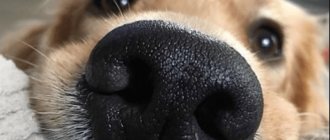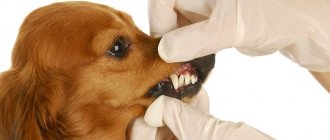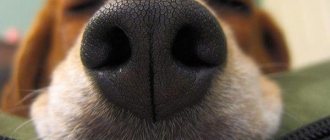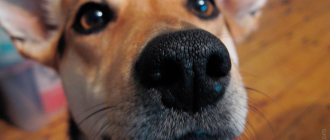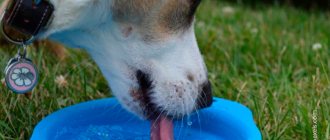A dog's nose is an amazing organ that allows the animal to subtly sense and distinguish smells. After all, smell is his main way of exploring the world and communicating. The structure of the respiratory organ is designed so that the dog can receive maximum information and, therefore, feel confident. It is not surprising that the condition of this organ is at the same time an indicator of its well-being. From this article you will learn why a dog’s nose can be dry and warm, what this condition indicates, and what the owner should do.
What should a healthy dog's nose look like?
If the dog is healthy, then the tip of his nose is moderately moist and cool. The mucous membrane of the lobes remains pale pink when at rest and changes color intensity to pinkish-red when excited. On a dark nose, color changes are invisible.
The appearance of cracks and dryness indicates a limitation or complete loss of functionality of the wetting glands. Over time, this leads to swelling of the mucosa, the formation of ulcers and crusts.
Physiology of the dog's nose
The sensitivity of a dog's sense of smell is explained by the unusual structure of the organ. Unlike a human's, a dog's nose is equipped with four holes: front and side. This structure eliminates the mixing of odors. Inhaled air enters through the nostrils, and exhaled air exits through holes located on the sides.
Another feature is the mucous film covering the outer and inner surfaces of the olfactory organ. It not only increases sensitivity, but also performs an antibacterial function.
Video “The world of our smaller friends”
This video will talk about how dogs see the world through their noses.
Sorry, there are no surveys available at this time.
Was this article helpful?
Thank you for your opinion!
The article was useful. Please share the information with your friends.
Yes (100.00%)
No
X
Please write what is wrong and leave recommendations on the article
Cancel reply
Rate the benefit of the article: Rate the author ( 6 votes, average: 4.67 out of 5)
Discuss the article:
Non-dangerous causes of a dry and warm nose in a dog
If the puppy has a dry and warm nose, then his first teeth or molars may erupt. After the full combat kit appears, the baby’s condition should return to normal.
A predisposition to poor mucus production, inherent from birth, is also not a cause for concern. This anomaly is inherited and is not considered a dangerous abnormality.
In the absence of pathology, the unusual condition covers a short period of time and is not accompanied by other alarming symptoms. A healthy dog remains active and eats with the same appetite.
Dream
The mucous membranes dry out and heat up during sleep, since at this moment all processes slow down. The usual humidity returns some time after waking up.
Fatigue
Increased physical activity takes a lot of energy. If your pet has recently been running with other animals or following complex commands, then he needs a little break.
Overexcitement
An increase in the temperature of a dog's nose indicates internal distress. Having recovered from fright or excessive joy at the sight of the owner, the pet will definitely return to normal.
Hot weather
Never leave a defenseless pet under the scorching sun. Prolonged exposure to heat can lead to heatstroke or sunstroke.
Frosty weather is no less dangerous. Cold combined with strong wind quickly dries out the mucous membrane, leading to its cracking.
Dryness in the apartment
During the heating season, the air in the apartment becomes too dry. Due to the lack of moisture, the skin constantly dries out and cracks, causing unpleasant consequences for four-legged pets and their owners. In such cases, buying an air humidifier can help.
Pregnancy and childbirth
Another possible reason is hormonal imbalance. It occurs during pregnancy, childbirth, lactation and estrus.
Characteristics of mucous membranes are normal
But much more attention should be paid to the appearance of the visible mucous membranes of the nose. They can be seen by looking inside the nasal passages. Of course, ideally, special dilators are used for this, but in large animals the mucous membranes can be seen without instruments. From them we can say even more about the health of the animal:
- Normal mucous membranes have a uniform pink color.
- There should be no clearly visible vascular network or redness on their surface.
- Normally, the mucous membranes have an absolutely smooth, uniform surface without signs of ulceration; there should be no scratches, wounds or erosions.
- Of course, mucous membranes cannot be dry!
- As in the previous case, no catarrhal (mucous), purulent or other type of exudate should be observed on the surface of healthy tissues. All these signs (if present, of course) indicate the presence of an inflammatory process in the nasal cavity.
Pathological causes
For pathological reasons, dryness and fever persist for several days. The dog's condition is gradually deteriorating, complicated by accompanying symptoms.
Diseases
If your dog has a dry and warm nose, then the cause of the discomfort may be an illness. A similar symptom is typical for:
- Autoimmune pathologies
. Most often, four-legged pets are affected by pemphigus. Its presence can be easily determined by the bubbles on the nose filled with liquid. When they crack, harmful microorganisms enter them, which complicates the course of the disease.
- Colds
. If your dog has a dry and cold nose, severe lethargy, coughing and runny nose, be sure to take him to the vet. Pets often catch colds due to drafts or walking without protective clothing.
- Infections
. The most dangerous are rabies and canine distemper. If you experience unsteady gait, drooling, fear of light or fear of water, immediately seek help by isolating the patient in a separate room.
Remember that rabies has no cure and is deadly to humans. For your pet's safety, be sure to follow the vaccination schedule recommended by your veterinarian.
Allergy
Due to the variety of allergens, it is important not to begin treatment until the cause of the illness is determined. The most effective way to combat allergies is to eliminate the unfavorable factor: pollen, food, bedding material, household chemicals. If symptoms are pronounced, antihistamines may be taken. It is better to check the dosage and name of the medicine at your veterinary clinic.
Injury
If an animal is injured by a fall, in a fight, or by a foreign object, inflammation may develop at the site of the injury. In addition to high fever, it will be accompanied by severe drowsiness, lameness, loss of appetite and pain.
Severe stress
Prolonged stress is dangerous for the psyche, so monitor your pet's condition during moving, vaccination, haircut, traveling on public transport and other hectic events. If you notice anxiety, try to calm the animal down with words and affection. If the situation repeats, consult your doctor about sedatives.
Parasitosis
Prolonged infection with helminths is fraught with severe intoxication and failure of internal organs. These terrible consequences can be avoided by taking quarterly anthelmintics that destroy larvae and adult parasites.
Poisoning
If a dog has a dry and hot nose after eating waste from a trash can, then there is a high probability of poisoning. Intoxication with poisons is especially dangerous. Without timely help, the animal dies, suffering from convulsions.
Interesting Facts
The pattern on the nose is unique and individual for each dog, like human fingerprints, the pattern of which is never repeated. Animals are identified by the pattern on the lobe.
The color of a dog's nose directly depends on the color of its coat. So, for example, in individuals with white spots on their fur, the nose may be spotted, while in red individuals the pigmentation is brown. But under the influence of external factors or diseases, pigmentation disorders of the nose are possible.
Associated symptoms
If additional symptoms appear, it is better to show your pet to a veterinarian. It is very difficult to make a diagnosis on your own, since most diseases have a similar clinical picture.
Lethargy
The dog does not respond to commands, refuses to play and does not leave the bed. A lethargic state is the first alarm bell, signaling illness, along with poor appetite.
Lack of appetite
Loss of appetite is characteristic of elevated temperature. Due to weakness, the body does not have the strength to digest foods; reduced activity reduces the need for calories. Additionally, there may be an increased or decreased interest in water.
Increase or decrease in temperature
A rise in temperature above 39.3°C or a drop below 37.3°C is characteristic of poisoning, parasitosis, hypothermia or internal bleeding. Be sure to show your pet to a doctor if his condition does not improve within 24 hours.
Rapid breathing
If the dog breathes heavily and frequently at rest, then the cause of shortness of breath lies in pathology. Breathing disorders are typical for heat strokes, allergies, pulmonary parasitosis, injuries, infections and poisonings.
Salivation
This symptom is one of the signs of rabies. An infected pet can infect others through saliva, so contact a veterinary clinic and prevent any contact until doctors arrive.
Runny nose, cough
Similar symptoms always accompany a cold. Due to congestion in the nasal sinuses, your four-legged pet may snore in his sleep. The condition is complicated by the appearance of wheezing and can develop into pneumonia.
Severe itching
An attack of scabies occurs upon contact with allergens and after infection with parasites. If an animal suffers from constipation, vomiting, swelling and peeling of the skin, then it will have to undergo diagnostics at a veterinary clinic.
Skin and coat problems
Redness and rashes on the skin occur with allergies and pemphigus. Over time, the animal may begin to lose hair. If extensive swelling or swelling appears on the body, this may indicate injury. Particularly dangerous are injuries with ulcerations, which are fraught with infection at the site of the open wound.
Vomit
One of the very first symptoms of intestinal and stomach disorders. But it is important to consider that it can be a common occurrence for a dog to greedily swallow bones. In most cases, when a dog vomits, he can eat it back. But if vomiting is accompanied by signs of suffocation and his legs are bent with his head hanging low, then it is a clear sign that he is about to vomit, you should quickly go outside with him and let him breathe fresh air so that he will be released.
All these symptoms may appear gradually and not all at once, or it happens when one is pronounced and the other is completely normal. But at the same time, the number of pathologies may increase.
What should the owner do?
When making a decision, consider the condition of the pet. If it is satisfactory, then you can help yourself.
At home
Don't panic if there are no alarming symptoms. The consequences of harmless causes go away on their own, so try to relax and observe.
If you feel lethargic and have poor appetite, take your temperature. Minor deviations can be corrected by drinking plenty of fluids, ventilating or wrapping up. Use simple and safe methods, avoiding taking antipyretic drugs - such treatment can aggravate the animal’s condition, so it is better to entrust the choice of medications to a veterinarian.
To eliminate dryness, use a softening ointment or cream with chamomile and calendula. They will prevent cracks from appearing. The same products are suitable for healing wounds after injury.
Can dogs get sunburn?
Like people, dogs like to go overboard on the first nice days of spring or summer, and spend a little more time in the sun than is prudent. If dogs spend more time in the sun than they should (especially those with pink or light-colored noses), they can get sunburned. Some dogs with short or light hair may suffer burns all over their body. Repeated sun exposure over many years can also lead to skin cancer. Provide your dog with a shady spot if he is outside all day, or consider keeping him indoors during the middle of the day at the beginning of tanning season. Sunscreen will also help, but most dogs will simply lick it off. The same applies to ointments after sun exposure or lotions. If your dog has a serious burn that is blistering or bleeding, you should contact your veterinarian.
